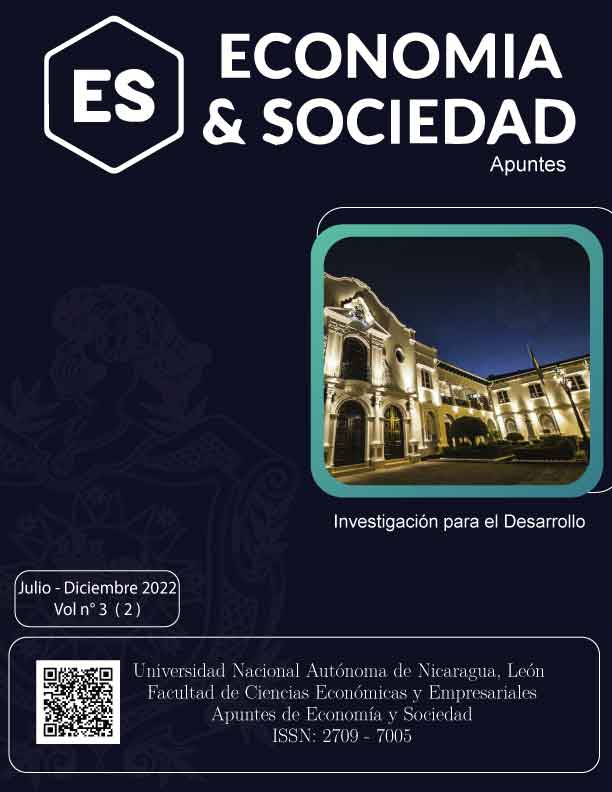Comportamiento de clientes y vendedores en mercados informales. Caso de estudio en Santo Domingo, Ecuador
DOI:
https://doi.org/10.5377/aes.v3i2.15487Palabras clave:
Comportamiento del cliente, Comportamiento de los vendedores, Mercados informales, Proceso de ventas, Intención de compra, Puntos de venta, Entorno de mercadoResumen
Los mercados informales, aunque no son ampliamente aceptados, contribuyen a la generación de empleo y facilitan el acceso a múltiples productos. Además de facilitar el flujo financiero dentro del territorio. Sin embargo, es un hecho que en este tipo de mercado no se cumplen muchos de los principios de comercialización como en los mercados formales. Este trabajo tiene como objetivo profundizar en las peculiaridades del proceso de comercialización de los mercados informales. Se realizó principalmente a través de la observación de 86 puntos de venta de un total de 777 que operan en el mercado, caracterizando variables como el comportamiento de clientes y minoristas, así como la variación de oferta y demanda en puntos de venta. A través de la investigación fue posible caracterizar variables relacionadas con el proceso de venta y el comportamiento de clientes y minoristas en un mercado informal en la ciudad de Santo Domingo, Ecuador. Se observó que el volumen de venta está relacionado con la ubicación del establecimiento, la circulación de clientes y las vías de acceso. Además, una mayor variedad de productos determina un aumento en las ventas, aunque un aumento significativo en la variedad puede afectar negativamente su influencia en los volúmenes de ventas.
Descargas
Citas
Bigné Alcañiz, J.E. (2020). Human interactions and research developments. European journal of management and business economics, 29(1), 1-2. https://doi.org/10.1108/EJMBE-03-2020-141
Bigné Alcañiz, J.E., Currás Pérez, R., Ruiz Mafé, C., & Sanz Blas, S. (2010). Consumer behavioural intentions in cause-related marketing. The role of identification and social cause involvement. International review on public and nonprofit marketing: official publication of the International Association on Public and Nonprofit Marketing, 7(2), 127-143
Boafo, C., Owusu, R.A., & Guiderdoni-Jourdain, K. (2022). Understanding internationalisation of informal African firms through a network perspective. International Small Business Journal: Researching Entrepreneurship, 40(5), 618-649. https://doi.org/10.1177/02662426211054099
Fouskas, T. (2018). Repercussions of precarious employment on migrants’ perceptions of healthcare in Greece. International Journal of Human Rights in Healthcare, 11(4), 298-311. https://doi.org/10.1108/IJHRH-01-2018-0010
Gao, L., & Simonson, I. (2016). The positive effect of assortment size on purchase likelihood: The moderating influence of decision order. Journal of Consumer Psychology, 26(4), 542–549.
Goyal, Y. (2022). Responsibilization through regulatory intermediaries in informal markets: Examining the governance of prostitution in India. Regulation and Governance, 16(3), 858-874. http://doi.org/10.1111/rego.12298
Ha, N.H. (2014). Buy, sell and chatter: A case analysis of a Lisbon Flea Market. Unpublished Master’s dissertation, NOVA School of Business and Economics of Lisbon.
Horodnic, I.A., Ciobanu, C.I., Zaiț, A., & Williams, C.C. (2022). Who purchases from the informal economy and why? Frontiers in Psychology, 13, 940076. http://doi.org/10.3389/fpsyg.2022.940076
Hussain, R., & Ali, M. (2015). Effect of store atmosphere on consumer purchase intention. International Journal of Marketing Studies, 7(2), 35–43. https://doi.org/10.5539/ijms.v7n2p35
Ishak, F., & Ghani, N.H.A. (2013). A review of the literature on brand loyalty and customer loyalty. Paper presented at the Conference on Business Management Research, Universiti Utara Malaysia, Sintok.
John, R.M., & Ross, H. (2018). Illicit cigarette sales in Indian cities: Findings from a retail survey. Tobacco Control, 27(6), 684-688. http://dx.doi.org/10.1136/tobaccocontrol-2017-053999
Kahyalar, N., Fethi, S., Katircioglu, S., & Ouattara, B. (2018) Formal and informal sectors: is there any wage differential? The Service Industries Journal, 38(11-12), 789-823. https://doi.org/10.1080/02642069.2018.1482877
Kanagaretnam, K., Lee, J., Lim, C.Y., & Lobo, G.J. (2022). Trusting the stock market: Further evidence from IPOs around the world. Journal of Banking and Finance, 142,106557. https://doi.org/10.1016/j.jbankfin.2022.106557
Karrar, H.H., & Rudaz, P. (2022). A cautionary tale: Bazaar trade and limitations to growth in Georgia, Kazakhstan and Kyrgyzstan. Global Networks, 22(3), 530-546. https://doi.org/10.1111/glob.12367
Keng, C., Chang, W., Chen, C., & Chang, Y. (2016). Mere virtual presence with product experience affects brand attitude and purchase intention. Social Behavior and Personality, 44(3), 431–444.
Kiggundu, M.N., & Pal, S.P. (2018). Structure and Management of Formal and Informal Business Activities in Entrepreneurial Family and Small Firms in Africa. Africa Journal of Management, 4(3), 347-388.
Klevakin, A.N. (2018). Assessment of the impact of the narcotics market on the regional socio-economic development. Economy of Region, 14(1), 253-269. http://dx.doi.org/10.17059/2018-1-20
Koc, E., & Burhan, H.A. (2015). An application of Analytic Hierarchy Process (AHP) in a real world problem of store location selection. Advances in Management and Applied Economics, 5(1), 41–50.
Lamb, C., Hair, J., McDaniel, C., Boshoff, C., Terblanche, N., Elliot, R., & Klopper, H.B. (2012). Marketing. Cape Town: Oxford University Press Southern Africa.
Leung, K.M., Choy, L.H.T., & Chau, K.W. (2022). Examining informal housing supply through rent gap analysis: An empirical study of sub-divided units in Hong Kong. Cities, 126, 103666. http://doi.org/10.1016/j.cities.2022.103666
Liyun, C. (2011). Development of an integrated intelligent product assortment optimization model for apparel retailing. Unpublished PhD thesis. Institute of Textiles and Clothing, The Hong Kong Polytechnic University: Hong Kong.
Maroukis, T. (2018). Migrant care workers’ trajectories in a familistic welfare regime: labour market incorporation and the Greek economic crisis reality-check. Journal of Ethnic and Migration Studies, 44(14), 2358-2374. https://doi.org/10.1080/1369183X.2017.1346012
Martinez, L., & Rivera-Acevedo, J.D. (2018). Debt portfolios of the poor: The case of street vendors in Cali, Colombia. Sustainable Cities and Society, 41, 120-125. https://doi.org/10.1016/j.scs.2018.04.037
Mortenbock, P., & Mooshammer, H. (2016). Encountering the city: Urban encounters from Accra to New York. Ed. By Jonathan Darling, Helen F. Wilson. New York: Routledge.
Moslehpour, M., Aulia, C., & Masarie, C. (2015). Bakery product perception and purchase intention of Indonesian consumers in Taiwan. International Journal of Business and Information, 10(1), 63–94.
Neuwirth, R. (October 28, 2011). Rise of the shadow economy: Second largest economy in the world. https://bit.ly/3zauS8W
Petresu, M., & Bhatli, D. (2013). Consumer behavior in flea markets and bottom of the pyramid marketing. The Academy of Marketing Science Conference.
Pope, J.A., Lane, W.R., & Stein, J. (2012). A multiple-attribute decision model for retail store location. Southern Business Review, 37(2), 15.
Rajagopal, P. (2010). Coexistence and conflicts between shopping malls and street markets in growing Cities: Analysis of Shoppers’ Behavior. Unpublished manuscript.
Rojas, C., & Briceño, A. (2019). The effects of piracy on competition: Evidence from subscription TV. International Journal of Industrial Organization, 63, 18-43.
Shaw, J. E. (2018). The informal economy of credit in early modern Venice. Historical Journal, 61(3), 623-642.
Spassova, G., & Isen, A. (2013). Positive affect moderates the impact of assortment size on choice satisfaction. Journal of Retailing, 89(4), 397–408.
Sihvonen, J., & Turunen, L.L.M. (2016). As good as new – valuing fashion brands in the online second-hand markets. Journal of Product and Brand Management, 25(3), 285-295.
Sinha, M., & Sengupta, D. (2017). Determinants of participation of women in labour market: An empirical evidence from Nadia District of West Bengal in India. Man in India, 97(2), 239-255.
Stillerman, J., & Sundt, C. (2007). Embeddedness and business strategies among Santiago, Chile’s street and flea market vendors. In J. Cross & A. Morales (Eds.), Street entrepreneurs: People, place and politics in local and global perspective (pp. 180–200). Routledge.
Takaza, S.C., & Chitereka, C. (2022). An investigation into the livelihoods strategies of informal women traders in Zimbabwe. Journal of Innovation and Entrepreneurship, 11(1), 37. https://doi.org/10.1186/s13731-021-00175-3
Talamini, G., Li, W., & Li, X. (2022). From brick-and-mortar to location-less restaurant: The spatial fixing of on-demand food delivery platformization. Cities, 128,103820. https://doi.org/10.1016/j.cities.2022.103820
Titeca, K. (2018). Understanding the illegal ivory trade and traders: Evidence from Uganda. International Affairs, 94(5), 1077-1099. https://doi.org/10.1093/ia/iiy115
Venter de Villiers, M., Visnenza, A. & Phiri, N. (2018). Importance of location and product assortment on flea market loyalty. The Service Industries Journal, 38(11-12), 650-668. https://doi.org/10.1080/02642069.2017.1410541
livelihoods in South Kivu. Extractive Industries and Society, 5(1), 73-80.
Williams, C.C., & Bezeredi, S. (2018). Explaining and tackling the informal economy: a dual informal labour market approach. Employee Relations, 40(5), 889-902. https://doi.org/10.1108/ER-04-2017-0085
Yang, X., Dong, X., & Yi, C. (2022). Informal housing clearance, housing market, and labor supply. Labour Economics, 78,102199. https://doi.org/10.1016/j.labeco.2022.102199
Zainol, N.R., & Al Mamun, A. (2018). Entrepreneurial competency, competitive advantage and performance of informal women micro-entrepreneurs in Kelantan, Malaysia. Journal of Enterprising Communities, 12(3), 299-321.
Zelano, K. (2018). Balancing informality and need–policy responses to informal East-West migration in Austria, the Netherlands and Sweden. Policy Studies, 39(5), 535-559.
Zhang, M., & Zhao, P. (2018). The determinants of informal housing price in Beijing: Village power, informal institutions, and property security. Cities, 77, 117-129. https://doi.org/10.1016/j.cities.2018.01.018
Zhao, P., & Zhang, M. (2018). Informal suburbanization in Beijing: An investigation of informal gated communities on the urban fringe. Habitat International, 77, 130-142. http://doi.org/10.1016/j.habitatint.2018.01.006
Publicado
Cómo citar
Número
Sección
Licencia
Derechos de autor 2022 Universidad Nacional Autónoma de Nicaragua, León

Esta obra está bajo una licencia internacional Creative Commons Atribución-NoComercial-CompartirIgual 4.0.














